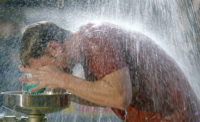
One of the reasons I rarely play golf is that, frankly, I’m not very good at it. Those who play regularly improve their skills, and those who don’t…don’t. Between the pressures of family life and working for a living, I’ve had precious little time to devote to getting good enough at golf to not aggravate myself trying. It’s interesting to note that specifying emergency showers and eyewashes can pose a similar challenge: If you do it with great frequency, you can become quite adept at navigating your way through the myriad products available. Weighing your specific needs; the hazards present, the potential for contact-type injuries, the number of employees (and others) at risk and environmental — either weather/climate or process driven — considerations is a daunting task all by itself. But, when you factor in the dizzying array of available products, each with its own features and benefits, construction material and design differences and application nuances, it can become an “impenetrable forest” of actual needs and useful (and not so useful) features. And, all of that doesn’t even consider budget constraints.
In a comfort zone
If you work in this arena every day you can get comfortable with selecting products from a group of personal favorites, based on successful applications over time. But, much like playing golf, if you don’t work with emergency showers and eyewashes regularly, you can spend significant time wading through products with subtle variations, which can lead to not-so-subtle “holes” in your response regimen.A family affair
To assist the relatively infrequent specifier in settling in on the appropriate overall solution, leading to the ideal final product selection, many safety professionals are relying on a process designed to narrow the field of products considered. The process, dubbed “Risk Rating” walks specifiers through a logical path that begins with a candid evaluation of the risks present in their operation, the number of people who could possibly require simultaneous emergency treatment and other environmental (weather and process) considerations. The aim is to select a general family, or category, of products that would meet their general needs.Once that decision is made, the specific configuration, construction material, installation and tempered water implications can much more easily be ascertained. Importantly, this approach also logically leads to consideration of any special issues surrounding integrating the new piece of equipment into an already existing shower/eyewash system. Once this step-by-step process has been followed, the choice of an appropriate shower and/or eyewash is quite literally made.
Using the “Risk Rating” technique, the “families” of products considered include portable and plumbed-in eyewashes, eye and face washes (with laboratory models categorized separately), drench showers and combination drench showers/eyewashes, as well as drench showers with eye and face washes. And, for special (mostly outdoor cold or hot climate) applications, the “Risk Rating” process can lead to a clear understanding that a plug-and-play Enclosed Emergency Environment (E3) is in order. These products package shower/eyewash (or eye/face wash) capabilities, with tempering and recirculation in an enclosed booth. All that’s required is to provide power and water supply lines and it’s ready to go.
“Risk Rating” is a unique way of navigating the array of products available, while also assuring that you are considering the current state-of-the-art. Like so many highly technical products, emergency response assets tend to change as regular advancements are made.
